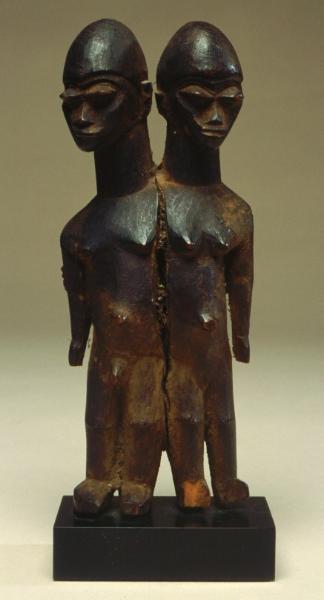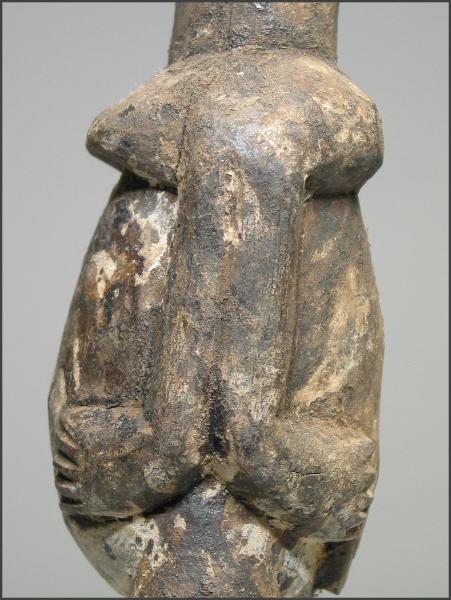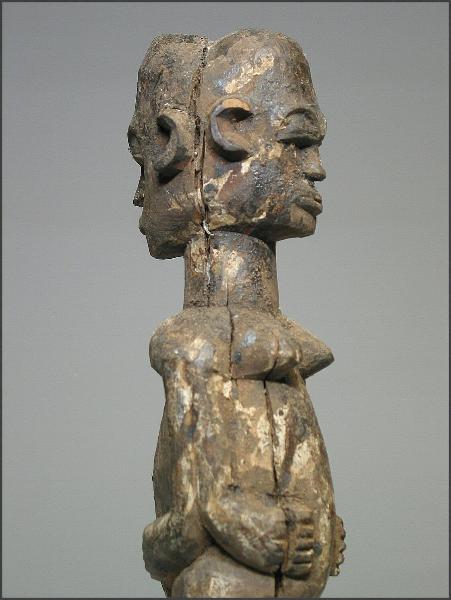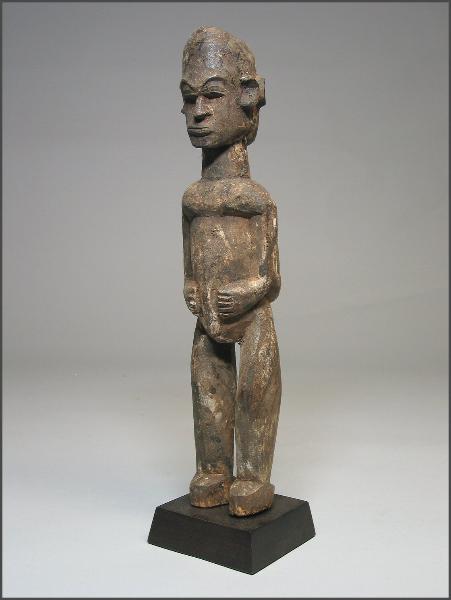
| Lobi Bateba Ti Bala Dorka (janus figure) |
| The Lobi people live in a vast geographical area that stretches from Burkina Fasso, to the Ivory Coast and into Ghana. Villages are spread out over wide areas and are made up of several compounds. The Lobi community is not organized on the basis of kinship or political ties and lacks any kind of centralized political authority in the form of a chief king or council of village elders. Instead the members of the community are united by common adherence to the cult of a nature spirit called “thil” (pl thila) and the rules that determine correct social behavior in the community are the rules that the spirit dictates through the diviner (thildar). The thila are invisible spirits of nature with certain supernatural abilities and powers that they can use for malevolent or benevolent ends. Each village has a particular spirit (dithil) that is responsible for the entire village. Social behavior is regulated by these thila, whose will is passed to ordinary people by priests and diviners. Wooden or clay sculpture, called bateba, act as an intermediary between a particular thil and the Lobi community. Lobi bateba figures have a wide degree of style and are made for a wide range of purposes. In Lobi communities anyone can learn to carve, it is not limited to people with specialized training. Lobi bateba figures are believed to be able to act in behalf of their owner, they are considered a living being and have the ability to act out against forces that could harm it’s owner or bring good things to it’s owner depending on it’s intended purpose. Very basic definitions BATEBA - Generally in literature on the Lobi the term "bateba" translates to a "wooden carved figure" BATEBA PHUWE - Normal or ordinary Bateba These figures usually have no specific defining posture and are often figures with arms straight down and the figures are looking straight ahead and often have a grim look on the face. These figures can have a variety of different functions. BATEBA Tl BALA - Unusual or extraordinary Bateba (sub categories Thil Dokra <janus figure>, Betise <mating couple>, maternity figures) Thil Dorka - Figures with two heads represent deities whose ability to see in several directions at once makes them exceptionally dangerous and powerful Betise - Figures depicting a man and a woman making love (the man always positioned behind the woman) are prescribed for single men so that they find a wife or to women to avoid sterility or wished to have a child. BATEBA YADAWORA - Sad Bateba Some figures are carved with sad expressions or have a hand touching the face because their function is to mourn for their owners. BATEBA Tl PUO - Dangerous Bateba Often referred to as Bateba Duntundara as well, these figures are considered dangerous and block entrance to harmful forces such as disease or witchcraft, and are depicted with one or both arms held up. BATEBA BAMBAR - Paralysed Bateba Figures depicting a seated man or woman with their legs stretched out in front of them are called bamgbar/bambar. According to certain soothsayers, these protect children and the elderly from paralysis. The Lobi often have conflicting interpretations of the meanings of the figures, and there are also varied meanings on similar figures because of regional variances. References: A History of Art in Africa, Lobi Art and Culture, The Lobi of Burkina Fasso, Lobi Skulpturen If you are interested in learning more about the Lobi, CLICK HERE to go to some great online reference articles. Link will open in a new window. |
| Lobi Bateba Ti Bala Dorka (janus figure) (unusual or extraordinary bateba) 13" tall Provenance: Tabwa Gallery, NY, NY Photos: Tabwa Gallery |
|
Other examples for reference purposes

| A Lobi figure from the Maurer Collection bateba Figure (Lobi) 7.2" http://www.amherst.edu/~afroart/14maurer.html |
|
| Figure with two heads, Thil Dokpa Lobi Wood H. 58 cm Tomkins Collection In Lobi cosmogony, Thil Dokpa are spirits of the bush, above human beings and below Thila, invisible spirit creatures with human properties and characteristics. Thil Dokpa "are considered as living beings, active from the moment they are set upon an altar... They are then able to see, to communicate between themselves, and to protect and help humans in many ways and in various practical domains of daily life...once installed on the altars, [they] become active auxiliaries of the invisible spirits, the Thila, against witchcraft, evil spells and sickness and, on the other hand, to bring wealth, fertility, marriage, strength and happiness to whomever places them on his altar."(Giovanni Franco Scanzi 1987:31, 34) Provenance: Parcours des Mondes, Paris, September 2004 |


| Large, carved hardwood standing figure, with male and female figures standing back to back, (unusal to have figures of both sexes). Abstract, cubistic style, protruding stomachs and navels, legs slightly bent at knees. Front of one foot missing, chip off other, some old minor insect loss. Very well carved for a large Lobi figure. Provenance: Ex. Jan Baum Gallery, LA, CA. https://www.arteprimitivo.com/scripts/detail.asp?LOT_NUM=101110 |

| Size: 14-3/4"H. Description: A hardwood abstract style carving having a double elongated neck, which creates a wide sling-shot form, surmounted with two similar cubistic style human heads. The single body form is also rendered in a cubistic style. Dark brown surface, with some applied traces of bird feathers, encrusted old patina. Tip of left toe missing, otherwise exc. cond. Wood base. Provenance: Ex. Eric Robertson Gallery, NY. https://www.arteprimitivo.com/scripts/detail.asp?LOT_NUM=101084 |












